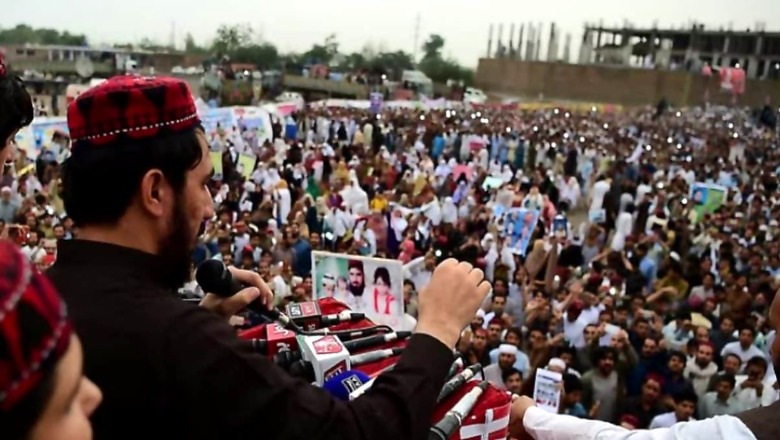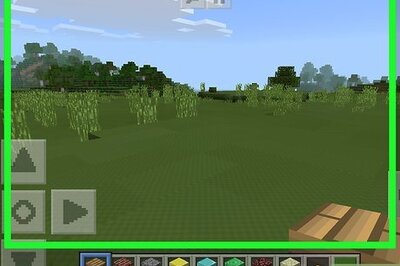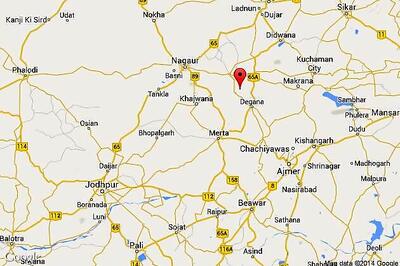
views
The Pashtun National Jirga, held on October 11, 2024, in Khyber Pakhtunkhwa faced concerted efforts by state agencies in Pakistan to disrupt its proceedings. These included the intimidation of Pashtun leaders, arbitrary detentions of Jirga organisers and PTM coordinators, and road blockages. The Jirga encampment was attacked several times, resulting in the death and injury of innocent Pashtuns. Due to security concerns, police obstruction, and the martyrdom of five Pashtun youths in a shootout, the Jirga was delayed by a day and officially opened on October 12, 2024.
Despite these challenges, tens of thousands of people attended the Jirga under the leadership of Manzoor Pashteen, head of the Pashtun Tahafuz Movement (PTM). Prominent political figures included Mohsin Dawar (PTM representative), tribal leader Malik Naseer Kokikhel Pashtun, religious scholar Maulana Khanzeb, Barrister Gohar Ali Khan, Aimal Wali Khan, Professor Ibrahim, Mian Iftikhar Hussain, Mohammad Ali Shah Bacha, Sikandar Sherpao, K-P Assembly Speaker Babar Saleem Swati, Provincial Opposition Leader Dr Ibad, and Federal Minister Amir Muqam.
Women played a significant role, including the mothers of Army Public School victims, highlighting the human toll of the conflict and emphasizing the growing importance of women in advocating for justice and peace within Pashtun society.
The Jirga also highlighted PTM’s White Paper, “War and Militarisation Damages: The Case of Pashtuns”, which documented the devastating effects of military operations. Over 3.7 million civilians were displaced due to military activities, and 75 per cent of Pakistan’s 68,691 terrorism-related fatalities between 2000 and 2024 occurred in KP, FATA, and Pashtun Balochistan. The economic devastation was severe, with poverty exceeding 27 per cent in affected areas, and key infrastructure, including schools and healthcare facilities, severely damaged. In South Waziristan, 178 landmine explosions resulted in 800 deaths, the impairment of 250 children, and the loss of 4,000 cattle. PTM registered 279 landmine cases and documented 4,952 missing persons across 26 districts.
The Jirga concluded with a series of resolutions. It ordered the Pakistani army, ISIS, and the Taliban to withdraw from Pashtun areas within 60 days. It also decided that electricity generated in the Pashtun homeland would be free in tribal districts, with a cap of Rs 5 per unit in other regions. Furthermore, the restoration of pre-2010 transport and trade routes along the Durand Line was mandated. The Jirga also resolved that a Loya Jirga would visit various Pashtun areas to resolve local conflicts, and a ban on all forms of idolatry was announced.
Moreover, it was declared that Pakistan’s existing legal framework, a legacy of British colonial rule, was unsuitable for free citizens. In response, the Jirga called for the formation of a Pashtun national army comprising 200,000 youth to ensure the safety of Pashtun lives and property. Manzoor Pashteen also proposed the formation of a Pashtun Qaumi Lashkar, tasked with protecting the Pashtun people and addressing issues such as disappearances and killings.
What is Jirga?
In Pakistan’s socio-political fabric, the Jirga system has long been central to conflict resolution, especially in the Pashtun tribal regions. This traditional tribal council, consisting of community elders, mediates disputes through consensus and provides swift, informal justice. Operating at the grassroots level, Jirgas are often turned to in serious matters such as murder, violence, and financial disputes, where formal courts are seen as slow or ineffective at fostering reconciliation between parties. By resolving conflicts within the community, jirgas save time, and financial resources, and prevent the need for police or judicial involvement. Deeply rooted in Pashtun traditions, Jirgas not only address individual disputes but also deliberate on broader social issues, maintaining their significant influence in local governance.
Reasons of Pashtun Tahafuz Movement to Promote Jirga
The Pashtun Tahafuz Movement (PTM) supports the Jirga system in Pakistan for several strategic reasons that align with its broader objectives of advocating for Pashtun rights and addressing historical grievances. Primarily, the PTM seeks to restore and reinforce traditional Pashtun cultural practices, as the Jirga embodies a grassroots mechanism for conflict resolution that resonates with the community’s heritage.
Furthermore, the PTM views the Jirga as an effective means of local governance, empowering community members to address their issues independently of state mechanisms, which are often perceived as ineffective or oppressive. Supporting the Jirga also aligns with the PTM’s commitment to peaceful activism, facilitating dialogue and reconciliation rather than resorting to violence. The Jirga provides a vital platform for the Pashtun community to voice their concerns, including enforced disappearances and extrajudicial killings, thereby raising awareness on both national and international stages. Additionally, the Jirga fosters unity among Pashtuns by bringing together elders and community members to collectively address issues, strengthening social cohesion. Ultimately, by endorsing the Jirga, the PTM aims to advocate for the rights of Pashtuns within a framework that honours their cultural identity while addressing contemporary political demands.
Pakistan Government and Jirga
Since its independence, Pakistan has defined itself as an Islamic nation, predominantly influenced by Punjabi identity among the elite. This identity has systematically marginalized minority rights, imposing severe restrictions on their expression, ranging from blasphemy laws to the abduction and forced conversion of Hindu girls. The Pashtun Tahafuz Movement (PTM) has emerged as a crucial voice for the Pashtun community, advocating for their rights through peaceful means. The Jirga system also plays a vital role in restoring the cultural and ethnic values of Pashtuns, representing a significant step toward reclaiming their right to expression.
The Pakistani establishment harbours significant apprehensions regarding the Jirga, which serves as a crucial platform for the Pashtun community to mobilise and articulate their grievances, potentially fostering widespread support for their rights. This gathering poses a challenge to the state’s prevailing narrative and authority, as it allows the community to express demands for justice and accountability, which may undermine the establishment’s control. Historically, peaceful assemblies have the potential to catalyse significant political movements, and there is concern that Jirgas by suppressed Pashtuns could inspire similar actions, threatening the status quo.
In March 2010, the government introduced legislation to curtail Jirgas and strengthen the judiciary, aiming to reduce reliance on tribal systems. In January 2019, Pakistan’s Supreme Court declared Jirgas unconstitutional, reinforcing the authority of formal legal institutions.
The writer is an author and columnist and has written several books. His X handle is @ArunAnandLive. Views expressed in the above piece are personal and solely those of the author. They do not necessarily reflect News18’s views.














Comments
0 comment